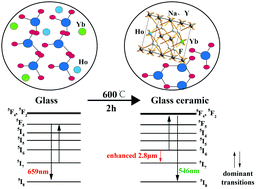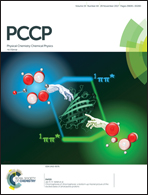Different dominant transitions in holmium and ytterbium codoped oxyfluoride glass and glass ceramics originating from varying phonon energy environments
Abstract
Transparent oxyfluoride glass and glass ceramics doped with 0.5% Ho3+ and 1.0% Yb3+ ions have been prepared. X-ray diffraction and transmission electron microscopy demonstrated the formation of NaYF4 nanocrystals during the heat treatment process. Raman spectra indicated the variation of glass structure brought about by the formation of NaYF4 nanocrystals. XRD curves and Judd–Ofelt intensity parameters confirmed the incorporation of Ho3+ into NaYF4 nanocrystals. Significantly enhanced visible upconversion and 2.85 μm emissions were achieved in glass ceramic under 980 nm laser diode pumping. A broadband spectrum with a full-width at half-maximum close to 132 nm was obtained in the glass ceramic. Besides, the calculated peak emission cross section was 0.6 × 10−20 cm2, suggesting that the glass ceramic is a promising gain material that can be applied to broadband amplifiers in the mid-infrared region. Furthermore, energy transfer mechanisms in glass and glass ceramics were proposed based on visible to mid-infrared emission spectra. It was found that the change in the photon energy environment around rare earth ions induced different dominant transitions in glass and glass ceramic. Finally, the influence of phonon energy on the transition processes was further quantitatively investigated, which may provide useful guidance for obtaining highly efficient 2.85 μm emission of holmium.

- This article is part of the themed collection: 2017 PCCP HOT Articles


 Please wait while we load your content...
Please wait while we load your content...